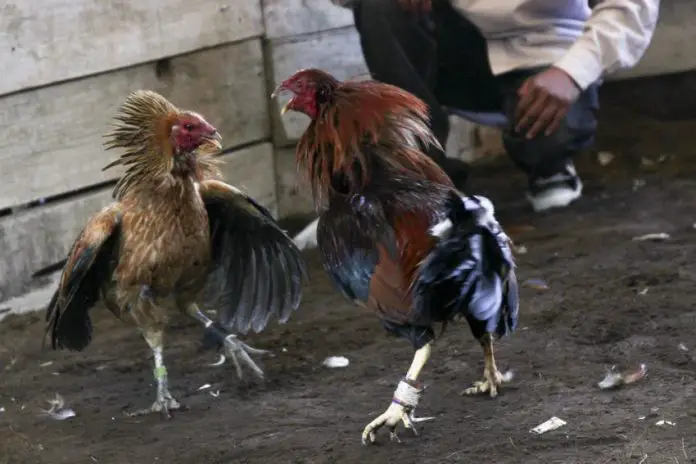This article was written by Aedan Seaver, a journalism student at the University of Oregon program, as part of a study abroad program in Querétaro, Mexico. Our CEO recently met with the students and the MND editorial team reviewed and selected the top articles to publish.
An enormous, severed bull’s head loomed out of the semi-darkness, looking very much alive from its mount above Quique Bandin’s living room mantle. Posters of bullfighters filled the walls and chicken-shaped trophies sat proudly on the coffee table — reminders of a uniquely Mexican family history.
Bandin, whose father was a bullfighter and chicken breeder, has spent his life raising and selling gamecocks — fighting roosters — to be used in cockfights worldwide. Although banned in many countries, the ancient tradition of cockfighting persists both legally and illegally as entertainment and as a piece of cultural heritage.

A cockfight unfolds in an enclosed, circular arena, called a “palenque” in Latin America. After the roosters are weighed and the bets are placed, judges and spectators look on as the birds peck and claw each other, often assisted by metal spurs fastened to their legs. The duel ends when one rooster is killed, badly injured, or withdrawn by its handler.
According to Bandin, the Mexican tradition of cockfighting can be traced to the 16th century Spanish colonization of Latin America. Today, it is simply a social reality. “These chickens have been here fighting since the time of our ancestors,” Bandin said. “Through the years, the culture has naturally strengthened and grown intertwined with the music and festivity of the local fairs.”
A 2018 review of Mexican gallistics — cockfighting — led by anthropologist Lorena Luna Rodríguez outlines a link between “combat birds and the fighting spirit,” associating gamecocks with “the incitement in man of the need to fight until the last drop of blood is lost.”
Although legal in many Mexican states, Bandin said cockfighting tournaments and the associated gambling are heavily regulated. “You have to get permits from the government and meet various requirements but this means safe, secure events,” Bandin said.

Clandestine cockfights, according to Bandin, can be dangerous. “If you play by the rules, everyone has fun,” he said. “You go to other places and there are bad people — money launderers and drug dealers, gambling lots of money.” For this reason, Bandin said he’s a proponent of sanctioned, well-organized cockfights, and that he only sells the animals he raises to trusted, credentialed buyers.
The Humane Society of the United States considers cockfighting an unnecessarily violent sport and a breach of animal rights. They point out that “even the birds who aren’t killed during cockfights suffer terribly,” citing steroid injection, separation from other animals and poor living conditions.
Bandin pointed out the hypocrisy of such U.S.-oriented perspectives by comparing cockfighting to factory farming. “Nowadays, the chickens you eat are raised in five weeks and then they’re in the supermarket,” Bandin said, “without ever seeing a ray of sunshine, without ever climbing a tree or running around scratching for worms in the dirt.”
Bandin’s gamecocks, he said, enjoy relative freedom as they mature naturally. They aren’t sold for combat until they reach two to three years of age. According to Bandin, little training is necessary, as fighting breeds are naturally aggressive. “It’s not what you feed the cocks or how you bathe them or anything,” he said. “It’s in their blood – it comes with their race. Like a fighting bull.”
Check out the other winning entry here.
Aedan Seaver is a student at the University of Oregon.
